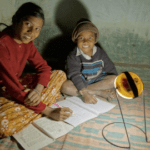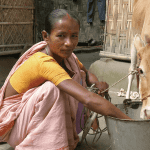Accomplishing the Impossible: Lessons on Scaling From BRAC Founder Sir Fazle Hasan Abed
In the last two decades, countless books and articles have addressed the challenges of going to scale in the development sector. To cite just one example, a 2017 Brookings report states that meeting the Sustainable Development Goals requires a “systematic approach” to scaling successful programs. Largely due to the complexity of most social programs, however—not to mention obstacles like climate change, war and COVID-19—this systematic approach remains out of reach. It seems we have yet to crack the scaling code.
For the last several years of his life, I was privileged to work closely with Sir Fazle Hasan Abed, a man who was arguably more successful than anyone at scaling effective poverty programs. Fifty years ago, Abed used the money from the sale of his small London apartment to start a nonprofit to aid war refugees in his native Bangladesh. He initially called it the Bangladesh Rehabilitation Assistance Committee, but eventually the name was shortened to just BRAC. In the decades that followed, BRAC’s myriad programs—involving community healthcare, microfinance, schools and more—scaled up to reach millions, including most of the Bangladeshi population. Queens, presidents and Nobel laureates would laud Abed and the organization he led until his death in 2019, with many calling it one of the world’s most effective anti-poverty organizations. “Over the past five decades, BRAC has changed the way the world thinks about health, education and development,” Bill Clinton said in March of this year, on the occasion of its 50th anniversary.
On August 1, my book “Hope Over Fate: Fazle Hasan Abed and the Science of Ending Global Poverty,” will be released by Rowman & Littlefield. On the surface, it is a biography of Abed, telling the detailed story of how he built BRAC, based on hundreds of hours of my conversations with him and his friends, family and co-workers. It is also the biography of an idea—the idea that hope itself, the sense of optimism and self-worth that so many poverty programs fail to nurture, can help break the poverty trap. This was the driving conviction of Abed’s life.
“Hope Over Fate” aims to shed light on what has made BRAC such a singular institution, one that runs a variety of programs that have achieved nationwide coverage, while also expanding internationally – even though it lacks the inherent reach of government agencies or the resources of large, for-profit corporations. No other nonprofit or social enterprise has done this at such a scale. Abed realized early on that to solve a problem as large as the poverty of Bangladesh (as his global ambition did not begin to take root until around the turn of the millenium), he would need to create solutions on the scale of the problem itself. As he saw it, programs that couldn’t be scaled up were not worth doing to begin with.
A simple formula for scaling: pilot, perfect, scale up
Yet readers looking to Abed for sweeping statements on scaling—perhaps a book-length listicle, like “seven steps for successful scaling”—may come away disappointed, since he had an aversion to that kind of pontification. His formula was simple enough that it could be written on the back of a cocktail napkin: Pilot, perfect, scale up. First, make sure your programs are effective on a small scale. Then “perfect” them by trimming the fat and reducing costs as much as possible. Finally, scale them up to reach as many people as possible.
To reduce BRAC’s reliance on donor funding, Abed also acted like a canny serial entrepreneur, scouting for moneymaking opportunities that would contribute to the organization’s budget while helping people in poverty. These opportunities have included refrigeration facilities for small-scale potato farmers, textiles, a dairy company—and of course, microfinance. And in the meantime, donors have continued to provide funding for its programs. Driven by these multiple revenue streams, BRAC has become known as the largest NGO in the world.
This simplified version of the story leaves out the stumbles, setbacks and personal tragedies Abed faced, including the death of Bahar Abed, his wife and effectively his partner at the helm of BRAC, during childbirth in 1981. Nevertheless, the story of his success at BRAC may seem too good to be true. Even after writing a book on the topic, it still remains unclear to me why Abed succeeded where so many others have failed. Was it his training as an accountant, the business acumen he gained from his work as a finance executive for Shell Oil – or perhaps his lifelong commitment to the cause? Probably, but there are skillful, entrepreneurial and dedicated people across the social sector. Was it the unique social and political environment of Bangladesh, which has the world’s highest population density (leaving aside statelets like Singapore) and a government that was content to let BRAC grow? Perhaps, but there must be more to it.
Boldness Mixed With Naivety: Understanding BRAC’s Scaling Success
As I listened to Abed’s many stories, I realized there was something else at play: a boldness mixed with naivety, which often led him to believe that the seemingly impossible was in fact achievable. There is one particular example of this approach that comes to mind, involving one of Abed’s closest co-workers in the 1980s and 1990s—a woman named Kaniz Fatema, a fellow Bangladeshi who led the launch and scale-up of BRAC’s primary school program.
Kaniz knew almost nothing about education when she joined BRAC in 1981, just as Abed himself had known little about development in general when he started the organization a decade earlier. In fact, most of his chief deputies had never worked anywhere else. Kaniz joined BRAC after a devastating personal loss: Her son, age six, had died unexpectedly in 1979, plunging her into a deep state of depression. She found the only thing that helped was hard work, so she took a job at BRAC—her first paid employment.
Now in her 80s and living outside Philadelphia, Kaniz provided me with uniquely refreshing views on Abed and BRAC, for while she greatly respected him, she did not lionize Abed as others did. Nor did she idealize her 17 years at BRAC, which she described as an organization where “proper dialogue” was too often lacking—yet that somehow succeeded in spite of itself. Under Abed’s supervision, Kaniz created and deployed the BRAC one-room schoolhouse model: a one-room building akin to a large shed, with glassless windows cut into walls of corrugated metal.
There are no desks in a BRAC school, and the children do not sit in a row, but in a large U, facing the center of a room often filled with the raucous sound of singing and rhymes. Barefoot, they kneel or sit cross-legged on woven mats laid down over a dirt floor, their flipflops in a tidy circle outside the door. Arranged neatly in front of each child are his or her learning materials—usually a slate and a primer, with chalk and pencils in a plastic cup or repurposed tin can. There was a clear reason for this simple, frugal approach: Abed’s goal was to exceed the abysmal quality of learning found in Bangladeshi public schools – without exceeding the government’s per-pupil cost, which was less than $20 per year in 1985.
Another of Abed’s deputies, the late Aminul (“Amin”) Alam—sometimes called Abed’s “field marshal,” for he had the persuasive powers of a bulldozer—ran BRAC’s rural development program at the time. Amin wanted to try everything under the sun to improve people’s health and livelihoods, even if it meant encroaching on Kaniz’s turf. “Amin would see tremendous possibilities of these teachers being used for other things,” said Abed. “He would suggest the teachers be mobilized for immunizing children, for instance. Kaniz would say, ‘No, no, no! I want my teachers completely focused on education.’”
Abed credited Kaniz with guarding the program vigilantly. “Ultimately Kaniz won that argument. Too many things, you don’t do so well. One or two things you do well. Kaniz wanted that. She was a good manager in that sense.” He added, “She would not take nonsense from anyone. She was in complete control of her program.”
Nevertheless, Abed was able to prevail in one area: convincing Kaniz to expand the program. BRAC had started with an initial pilot of 22 schools in 1985, but Abed insisted that it was both necessary and possible to do more. “Now you have 20 schools,” he told her. “Next month, I want to set up 200 schools.” Kaniz threw her hands up and said, “You can’t do that!” “Of course we can,” Abed replied calmly. “We’ll train people.” Abed had already set up a separate training division, with a network of centers around the country to onboard new staff and offer skills training to program participants – and he was now eager to leverage this resource more fully.
Recalling Abed’s determination to dramatically scale up the program, Kaniz said, “For me it was unrealistic. And in the next few years, we were going to have a few thousand schools. I banged on the doors of Amin and Abed, but no one would listen to me.”
As the program moved forward, the number of BRAC schools multiplied annually. At one point, Abed declared an ambition to open 100,000 schools. When the donor funding did not materialize, he had to stop expanding at “only” 64,000 schools, together serving more than 1.5 million students—often called the world’s largest private, secular school system.
Abed laughed when he recalled some of his arguments with Kaniz over the scope of the program. They accomplished remarkable growth and impact, with Kaniz leading the way—perhaps because she did not have the professional background that would lead her to insist, as others might have, that her boss was demanding something that could never be done. Hiring people based on their potential instead of their professional bona fides was one of Abed’s greatest strengths. Indeed, this may explain a great deal of BRAC’s story in general—people accomplishing the impossible because they lacked the “experience” to know any better.
“Hope Over Fate: Fazle Hasan Abed and the Science of Ending Global Poverty” is available in hardcover from Amazon, Barnes & Noble, Bookshop (which supports local bookstores), and directly from the publisher. Passages in this article adapted from the book appear courtesy of Rowman & Littlefield.
Scott MacMillan is the Director of Learning and Innovation at BRAC USA.
Photos courtesy of Amanda Mustard for FAO/IFPRI.
- Categories
- Education, Finance, Health Care, Social Enterprise



